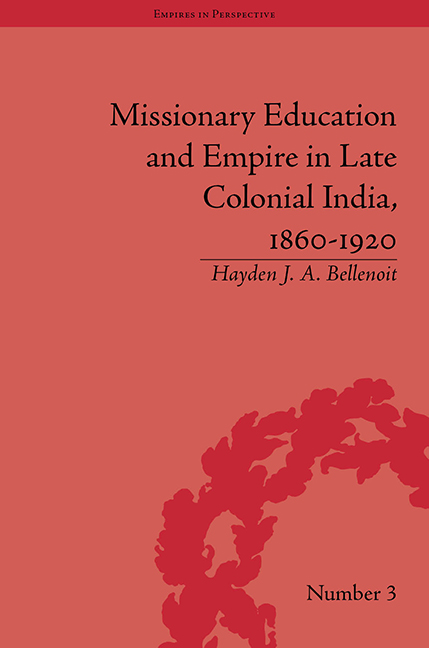Book contents
- Frontmatter
- CONTENTS
- List of Tables
- Acknowledgments
- Glossary
- List of Abbreviations
- Introduction
- 1 Knowledge, Religion and Education in Early Modern India
- 2 British Fears and Indian Society in the Emergence of North Indian Education, c. 1860–1920
- 3 Between East and West: Orientalism, Representations of and Engagements with India
- 4 The Failures of Education and its Sociological Bearings
- 5 Religious Interaction, the Curriculum and Indian Contestations of Late Colonial Knowledge
- 6 Maintaining Missionary Influence: Nationalism, Politics and the Raj c. 1870–1920
- Conclusion
- Notes
- Works Cited
- Index
6 - Maintaining Missionary Influence: Nationalism, Politics and the Raj c. 1870–1920
- Frontmatter
- CONTENTS
- List of Tables
- Acknowledgments
- Glossary
- List of Abbreviations
- Introduction
- 1 Knowledge, Religion and Education in Early Modern India
- 2 British Fears and Indian Society in the Emergence of North Indian Education, c. 1860–1920
- 3 Between East and West: Orientalism, Representations of and Engagements with India
- 4 The Failures of Education and its Sociological Bearings
- 5 Religious Interaction, the Curriculum and Indian Contestations of Late Colonial Knowledge
- 6 Maintaining Missionary Influence: Nationalism, Politics and the Raj c. 1870–1920
- Conclusion
- Notes
- Works Cited
- Index
Summary
One theme throughout this research has been the inefficacy of pedagogic methods in influencing Indian students and their religious convictions. By the end of the nineteenth century, the utility and effects of western knowledge upon Indian religions were, from one perspective, somewhat limited. This greatly shaped both the educational enterprise's efficacy and its ultimate orientation. On significant by-product of this development was that teachers and headmasters were increasingly concerning themselves with non-pedagogic issues – forms of affective knowledge. These concerns were, in turn, social and political ones. The most important manner in which affective knowledge manifested itself within the educational enterprise was in its interactions with Indian nationalism and patriotism. Missionaries, as we have seen, possessed far more intimate cultural and religious knowledge than the British themselves. This put them in a unique and ambiguous situation. And perhaps unsurprisingly, their attitudes towards the development of Indian nationalism were in many instances much more positive and engaging than that of India's increasingly reactionary colonial masters. The primary aim of this chapter is to explore the roles of Indian patriotism and nationalism, and their relationships with issues of pedagogy and residential space.
In doing so, this section also seeks to expand our understanding of the early 1900s and 1910s which, as Carey Watt has argued, have largely been viewed as ‘quiet’ and in abeyance between the outbreak of swadeshi agitation in 1905 and Gandhi's launching of Non-Cooperation in 1920. Upon closer inspection, much of the influence, building blocks and missionary impact on a wider Indian patriotism were laid during these crucial decades. The educational enterprise, for its part, played a largely unrecognized and precursory role in the run-up to the more ‘official emergence’ of Indian nationalism after 1920.
One significant by-product of this engagement and interaction was the development of a strikingly secular orientation of the education enterprise.
- Type
- Chapter
- Information
- Publisher: Pickering & ChattoFirst published in: 2014



